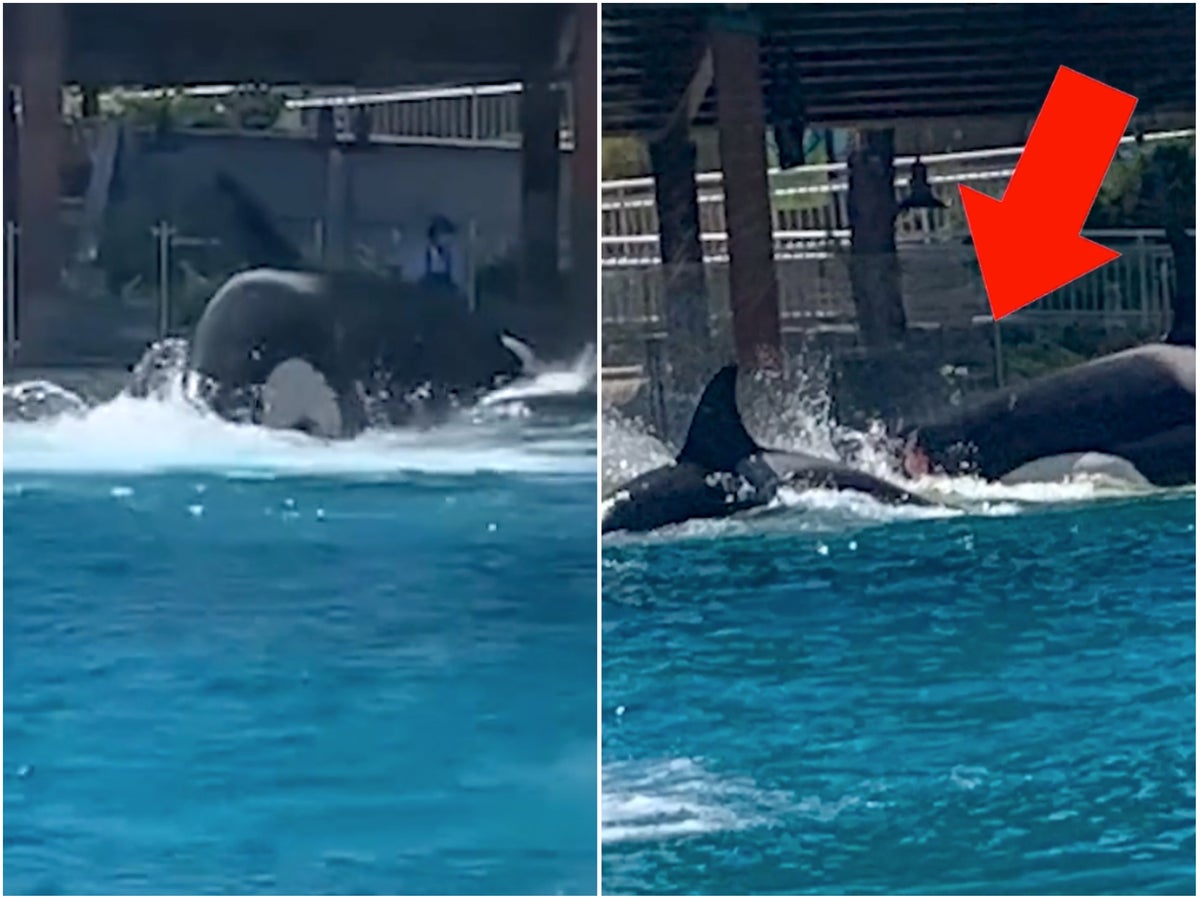
One of the Orcas at SeaWorld in San Diego has been filmed seeminlgy attacking another Orca sharing its tank.
People for the Ethical Treatment of Animals (PETA), an animal rights group, shared the video on Twitter on 5 August.
The footage was filmed by an eyewitness present at the park in southern California. SeaWorld told ABC7 that the video was “misleading and mischaracterised”.
PETA has long been calling for the release of the animals and in the new footage, one of the Orcas seems to be attempting to get up on a ledge in the pool as another killer whale appears to attack it from the waters. At the end of the footage, blood seems to have entered the pool.
“How is it still alive? ... I thought they hug each other, not fight each other,” a child is heard asking in the footage.
“We all immediately saw blood soaking the water, which triggered my nine-year-old daughter to start crying,” the eyewitness said, according to PETA.
“We would see bite marks and fresh wounds all over the side of the whale. Every couple seconds, two” or “more orcas would jump out of the water to” continue “attacking the hurt orca,” the witness added.
SeaWorld told ABC7 that the actions seen in the pool are commonly observed among Orcas in the wild and is considered normal behaviour.
They said the injuries were “minor and superficial abrasions that pose no serious health risk”.
PETA has urged the US Department of Agriculture (USDA) to look into the incident seen in the footage.
The animal rights group said in a statement that they want USDA to investigate SeaWorld San Diego for “apparent federal Animal Welfare Act violations over housing incompatible animals together, a practice the company has been warned against in the past”.
The group noted that the incident occurred one day after the death of Nakai, an Orca who had been at the park for 21 years.
“PETA points out that Nakai was involved in a similar incident when he was kept in a tiny concrete tank with incompatible orcas in 2012 and sustained puncture marks and lost a chunk of his jaw in an attack by two of them,” the group said.
The Executive Vice President of PETA, Tracy Reiman, said that “in two days, one orca has died and another has been attacked by other frustrated, closely confined orcas, resulting in a serious injury—and young children were witnesses to the carnage”.
“PETA is calling on the USDA to investigate SeaWorld for holding animals in conditions so stressful they would lead to horrific attacks and reminds families to stay away from any park that imprisons orcas or other animals,” she added.
The video shared by PETA was filmed by a woman called Kimberlee, who told KPBS that she didn’t want her last name to be used.
“One of my children pointed out that they saw blood in the water,” she told the outlet. “And so we kind of we stopped and we noticed that the whale started to beach itself, and so I decided to take pictures at that point.”
She added that she filed a report with PETA because SeaWorld didn’t appear to have suitable measures for such incidents, KPBS reported.
SeaWorld said the Orca behaviour is called rake making – running their teeth over the skin of another animal – and is considered normal.
The marine park’s chief veterinarian Dr Christopher Dold said in a 2015 YouTube video that the behaviour is a common occurrence, including in the wild.
“The suggestion that this is somehow abnormal, that this is an indicator of a problem, the truth of the matter is … all tooth whales and dolphins rake each other,” he said.
Kimberlee told KPBS that her family wouldn’t be going back to the facility.
SeaWorld said on Friday that Nakai died the previous night as a result of infection despite “aggressive therapeutic and diagnostic efforts”.
The park said in a statement that Nakai, born at SeaWorld San Diego in 2001, will be “remembered as a curious and quick learner, often picking up behaviors just by observing the other whales in his pod”.
“His contributions to helping improve the health and survival of whales in the wild cannot be underestimated and will never be forgotten,” the park added.
The San Diego Union-Tribune reported that the park now has eight Orcas.
SeaWorld said in 2016 that it would cease breeding Orcas at its facilities after a California Coastal Commission order and a decrease in visitors following the 2013 documentary Blackfish, which chronicled the life of the Orca Tilikum, who lived at SeaWorld Orlando for most of its life, KPBS noted.







